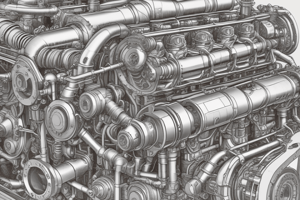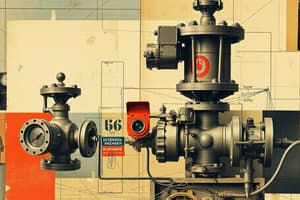Podcast
Questions and Answers
What is the primary purpose of calibrating valve positioners?
What is the primary purpose of calibrating valve positioners?
- To ensure accurate positioning of the valve (correct)
- To extend the overall lifespan of the valve
- To maintain the aesthetic appearance of valves
- To increase the power supply to the valve
Which factor is least important when calibrating a valve positioner?
Which factor is least important when calibrating a valve positioner?
- The physical appearance of the valve (correct)
- The response time of the valve positioner
- Environmental temperature during calibration
- The feedback signal accuracy
During the calibration process, what is typically tested?
During the calibration process, what is typically tested?
- Material properties of the valve
- Corrosion resistance of the valve
- Position response accuracy (correct)
- Power consumption of the valve
What could result from improperly calibrated valve positioners?
What could result from improperly calibrated valve positioners?
Which component is essential for the calibration of valve positioners?
Which component is essential for the calibration of valve positioners?
What does the calibration of valve positioners aim to achieve?
What does the calibration of valve positioners aim to achieve?
Which of the following is a key aspect during the calibration of valve positioners?
Which of the following is a key aspect during the calibration of valve positioners?
What role does feedback play in the calibration of valve positioners?
What role does feedback play in the calibration of valve positioners?
Which condition must be met for effective calibration of valve positioners?
Which condition must be met for effective calibration of valve positioners?
What is a possible outcome of inadequate calibration of valve positioners?
What is a possible outcome of inadequate calibration of valve positioners?
What is the main purpose of calibrating valve positioners?
What is the main purpose of calibrating valve positioners?
During calibration, what is the primary factor being adjusted?
During calibration, what is the primary factor being adjusted?
Which of these is NOT a typical step in calibrating a valve positioner?
Which of these is NOT a typical step in calibrating a valve positioner?
What is the role of feedback in valve positioner calibration?
What is the role of feedback in valve positioner calibration?
Why is proper calibration of valve positioners essential?
Why is proper calibration of valve positioners essential?
What is the outcome of a successful calibration of a valve positioner?
What is the outcome of a successful calibration of a valve positioner?
What is adjusted during the calibration process of a valve positioner?
What is adjusted during the calibration process of a valve positioner?
What is a critical requirement for effective calibration of a valve positioner?
What is a critical requirement for effective calibration of a valve positioner?
What is the purpose of feedback in valve positioner calibration?
What is the purpose of feedback in valve positioner calibration?
What can occur if a valve positioner is not properly calibrated?
What can occur if a valve positioner is not properly calibrated?
What is the main function of a valve positioner?
What is the main function of a valve positioner?
What is the primary purpose of calibrating a valve positioner?
What is the primary purpose of calibrating a valve positioner?
What is the most likely outcome of a poorly calibrated valve positioner?
What is the most likely outcome of a poorly calibrated valve positioner?
Which of these is NOT a typical step in calibrating a valve positioner?
Which of these is NOT a typical step in calibrating a valve positioner?
What type of feedback is usually employed in valve positioner calibration?
What type of feedback is usually employed in valve positioner calibration?
What is the function of the flapper in the Fisher 3582 positioner?
What is the function of the flapper in the Fisher 3582 positioner?
Which component is primarily responsible for receiving a control signal in the Fisher 3582 positioner?
Which component is primarily responsible for receiving a control signal in the Fisher 3582 positioner?
How is the position of the nozzle adjusted in the Fisher 3582 positioner?
How is the position of the nozzle adjusted in the Fisher 3582 positioner?
What role does the rotary shaft arm serve in the Fisher 3582 positioner?
What role does the rotary shaft arm serve in the Fisher 3582 positioner?
Which component of the Fisher 3582 positioner helps direct the fluid flow?
Which component of the Fisher 3582 positioner helps direct the fluid flow?
What is adjusted to control the amount of fluid flowing through the valve in the Fisher 3582 positioner?
What is adjusted to control the amount of fluid flowing through the valve in the Fisher 3582 positioner?
Flashcards are hidden until you start studying
Study Notes
Calibration of Valve Positioners
- Calibration ensures accurate control of valve positioners, essential for maintaining process consistency and safety.
- Involves adjusting the positioner to respond correctly to the input signal from the control system.
- Key parameters typically calibrated include zero-point, span, and sensitivity.
- Zero-point calibration sets the baseline position of the valve when the input signal is minimal.
- Span calibration adjusts the range of movement of the valve in response to the maximum signal.
- Sensitivity defines the ability of the valve positioner to respond to small changes in the input signal.
- Proper calibration improves the precision of flow control and reduces system variability.
- Regular calibration checks are necessary to maintain accuracy over time, compensating for factors like wear and environmental changes.
- Compliance with industry standards and manufacturer recommendations is crucial during the calibration process.
- Tools such as precision gauges and electronic calibration devices are often used to perform the calibration effectively.
Calibration of Valve Positioners
- Calibration ensures accurate operation of valve positioners, vital for controlling flow and pressure in various systems.
- Positioners receive input signals from controllers, adjusting the valve position to match the required process variable.
- Calibration involves setting the positioner to respond correctly to input signals, ensuring it achieves the desired valve opening.
Key Steps in Calibration
- Zero Adjustment: Establishes a baseline where the positioner responds precisely when no signal is received.
- Span Adjustment: Defines the maximum output signal and corresponding valve opening, essential for full range control.
- Response Verification: Testing the positioner's response to input changes ensures responsiveness and stability in operation.
Importance of Calibration
- Directly affects system efficiency and precision in processes such as chemical manufacturing and water treatment.
- Reduces the risk of equipment failure or inaccurate process control by ensuring valves operate as intended.
- Regular calibration can extend the lifespan of equipment and reduce maintenance costs.
Techniques for Calibration
- Manual Calibration: Involves physical adjustments and testing, often requiring skilled technicians for accuracy.
- Automated Calibration: Uses software tools for more precise and quicker calibration, minimizing human error.
- Field Calibration: Conducted in the operational environment to ensure real-world performance matches the design specifications.
Frequency of Calibration
- Depends on factors such as operating conditions, the type of valve positioner, and manufacturer recommendations.
- Common practice involves routine checks to maintain optimal performance, often on a scheduled basis.
Calibration of Valve Positioners
- Calibration ensures accurate response of valve positioners to control signals.
- Involves adjusting settings to achieve desired valve positions based on input commands.
- Improves performance by minimizing errors in valve operation.
- Typically performed using specialized calibration equipment, including pressure gauges and electronic test devices.
- Calibration process includes determining zero and span settings, ensuring the valve responds correctly between full open and full close positions.
- Regular calibration is essential to maintain efficiency and safety in process control systems.
- Variability in actuator response can be corrected through calibration to enhance system reliability.
- Factors influencing calibration include temperature, pressure, and specific fluid properties in the system.
Calibration of Valve Positioners
- Calibration involves setting the valve positioner to ensure the valve operates accurately according to the control signal.
- Essential for maintaining process control and performance efficiency in automated systems.
- Incorrect calibration can lead to poor valve performance, affecting the entire system's operation.
Steps for Calibration
- Connect the calibration equipment to the valve positioner's input and output connections.
- Verify the control signal to ensure it's working properly before starting the calibration.
- Set the valve to its fully closed position and adjust the positioner to register the appropriate signal.
- Gradually manipulate the control signal through its range while observing the valve’s position to ensure correct response.
Importance of Regular Calibration
- Regular calibration helps to identify wear and tear in the valve and positioner components, preventing unexpected failures.
- Ensures adherence to safety and operational standards, reducing risks in industrial processes.
- Increases the reliability and lifespan of both the valve and positioner, which can lead to cost savings.
Key Considerations
- Understand the type of valve positioner being calibrated, as different models may have varying procedures.
- Factors such as temperature, pressure, and the fluid’s characteristics can affect valve performance and should be monitored.
- Documentation of calibration settings and adjustments is crucial for future reference and regulatory compliance.
Calibration of Valve Positioners
- Calibration ensures accurate control of valve positioners, enhancing system performance and reliability.
- Necessary for maintaining optimal flow control in various industrial processes.
- Involves adjusting the positioner to ensure that the valve responds correctly to control signals.
Process of Calibration
- Initial Setup: Ensure all equipment is functional and properly connected.
- Input Signal: Apply a known input signal to the positioner, typically in the form of electrical signals like 4-20 mA.
- Position Feedback: Measure the actual valve position using feedback mechanisms (e.g., potentiometer, encoder).
- Adjustments: Modify the positioner’s settings to align the output position with the input signal.
Importance of Calibration
- Prevents discrepancies between the intended and actual valve positions, reducing control errors.
- Enhances process efficiency by ensuring the flow rates remain consistent with set parameters.
- Essential for safety in operations that involve hazardous materials, allowing for accurate emergency shut-off procedures.
Frequency of Calibration
- Regular calibration recommended based on operational demands and environmental factors.
- More frequent calibration needed in environments with fluctuating temperatures, pressure, or when equipment experiences vibrations.
Benefits of Proper Calibration
- Increases lifespan of the valve positioner and associated equipment.
- Minimizes downtime and maintenance costs by ensuring optimal operation.
- Facilitates compliance with industry standards and regulations.
Fisher 3582 Positioner Overview
- A Fisher 3582 positioner regulates fluid flow, applicable for both gases and liquids.
- The positioner operates through a series of interconnected components, enabling precise control.
Key Components
-
Input Cam:
- Receives signals and drives the rotary shaft arm's motion.
- Connects directly to input bellows for signal input.
-
Rotary Shaft Arm:
- Functions as the link between input cam and flapper.
- Converts cam rotation into a mechanical action to control valve position.
-
Flapper:
- Directly influences fluid movement by controlling a valve.
- Opens and closes based on the movement from the rotary shaft arm.
-
Nozzle:
- Channels fluid flow and is integral to regulating discharge.
- Positioned adjacent to the flapper for efficient operation.
-
Beam:
- Attached to the nozzle, providing stability and support for adjustments.
- Movement controlled by the travel adjustment screw to influence fluid flow.
-
Travel Adjustment Screw:
- Allows precise positioning of the nozzle, adjusting the valve's flow capacity.
- Essential for fine-tuning performance based on specific requirements.
-
Follower Assembly:
- Works with the nozzle to ensure coordinated movement and fluid control.
- Enhances system reliability through close alignment with other components.
-
Input Bellows:
- Engages with the input cam to translate external signals into mechanical movement.
- Critical for dynamic response to changes in desired fluid flow.
Studying That Suits You
Use AI to generate personalized quizzes and flashcards to suit your learning preferences.




